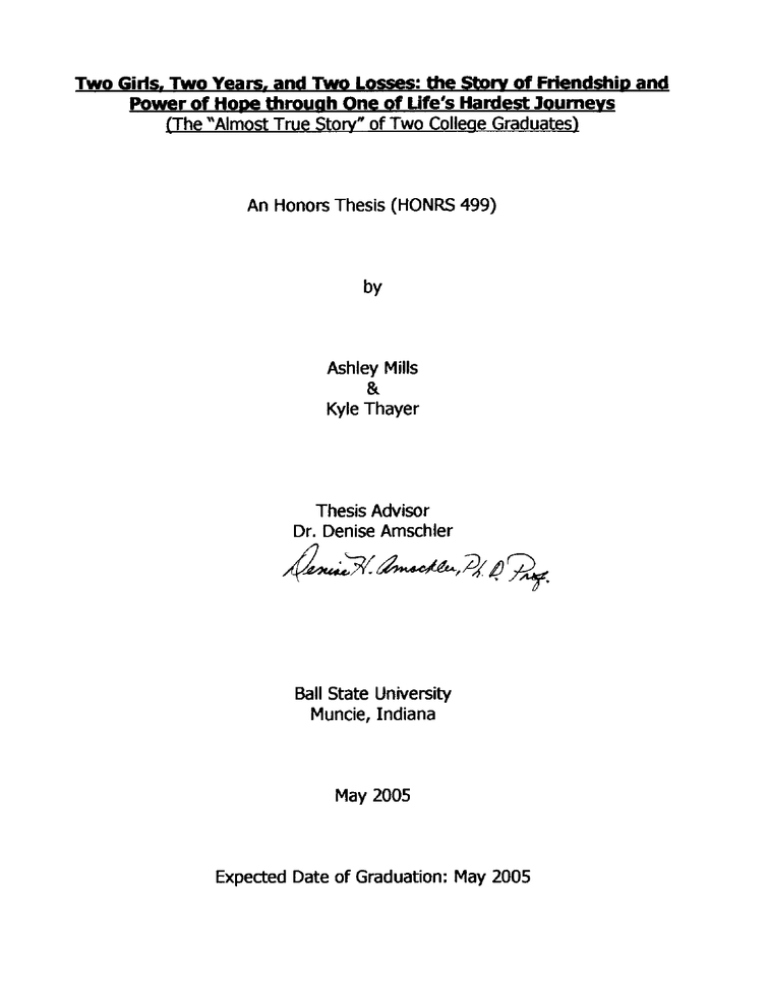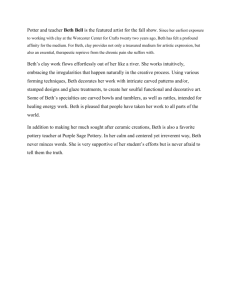the by Two
advertisement

Two Girls. Two Years. and Two Losses: the Story of Friendship and Power of Hope through One of Life's Hardest Journeys (The "Almost True Story" of Two College Graduates) An Honors ThesiS (HONRS 499) by Ashley Mills & Kyle Thayer Thesis Advisor Dr. Denise Amschler 4J~7!.~,q~~ Ball State University MunCie, Indiana May 2005 Expected Date of Graduation: May 2005 Abstract In many schools today, subjects such as cancer and illness are rarely, if ever, discussed. Our project, an illustrated children's book dealing with cancer, attempts to breech the gap between children and taboo subjects. This story follows the joumey of two young girls, Diane and Beth, who find comfort in each other due to similar life circumstances. This children's book also comes with a teacher's guide to help educators find ways to approach this difficult subject. This project weaves the academic and personal experiences of our lives into a useful classroom tool to help other educators. Acknowledgements • We would like to thank Dr. Denise Amschler for advising us through this project. She encouraged us through the process of creativity, content, and construction of this project. • We would also like to thank Dr. Sally Myers for giving guidance for the illustration process. • We would finally like to thank our families and friends; without the support given during our experiences, shared partially through the text of this book, we would not have been able to create this final product. We love you. Teacher's Guide for Two Girls, Two Years, and Two Losses: The Story of Friendship and the Power of Hope Through One of Life's Hardest Journeys. By Ashley Mills and Kyle Thayer Why teach about cancer? cancer is the second leading cause of death in the United States. Over one million people each year get cancer. One out of every 2 males will develop cancer at some time in their lives, and lout of every 3 females will develop cancer. Unfortunately, this horrible disease affects more and more people every day. Almost all children know about a family member or friend that has cancer but few children truly understand what cancer really is. Why is teaching about cancer difficult? Many teachers shy away from teaching about cancer for several reasons. First of all, the amount of curriculum that has been developed to help teachers with this subject is minimal. Along with limited curriculum, there is also the issue of dealing with the subject matter in general. This can be a difficult subject to teach as it deals with realms beyond academia. It is more challenging for teachers to teach about real life situations than it is to teach objective content matter. Grade Level/Indiana Academic Standards: There is no specific grade level towards which this book is geared. In the story, the main characters are moving from fourth to fifth grade, but that does not mean that the story is may be taught only at those grade levels. Students, both above and below these grade levels, can still understand the concepts in this book. Although it is not grade level specific, the maturity level of the class and its ability to handle the content must be assessed before presenting this book or subsequent lessons. Teachers can easily link these lessons to language arts, health, and art standards. Tips for Discussing Cancer with Children: Make students feel comfortable enough to discuss this difficult topic with you. Keep communication lines open by answering their questions in a concise and honest manner. Don't treat their questions as trivial or inappropriate. Many children do not know what is appropriate or inappropriate to ask about concerning illness and death. They simply question what they don't understand. Oftentimes, they will ask the same questions repeatedly. This is also normal behavior; consistency in answering these questions will assist the students' sense of comfort and understanding. At all times, including this unit plan, make it a point to distinguish between feelings and actions. For example, it is okay to be frustrated, but it is not okay to yell at someone. This will be helpful when discussing the emotions that arise when dealing with cancer. Remember that it is okay to not have all of the answers. Simply say "I don't know the answer to that". Be aware of how the students are reacting to the story. If a student is visibly upset, allow him or her to leave if he or she feels uncomfortable. Create an atmosphere of support by allowing other students to hug that student if it is within the comfort levels of all of the students. Using the book as a single lesson: When teaching about cancer, the goal should be to raise awareness of what cancer is, how it can be prevented, and how to cope with emotions that arise because of it. Lesson Objective: Students will demonstrate understanding and awareness of cancer, its prevention, and coping with the emotions it brings through activities such as answering questions, making a stamp or a quilt square to explain emotions, or by creating a graphic organizer for the story's content Reading the Story: Before reading the story, tell the students to look for certain emotions that Beth and Diane convey such as fear, anger, and sadness. Story Activities: There are several activities that can be done to assess student comprehension, and extend student learning. A graphic organizer is a great way for the students to organize their thoughts about the story on paper. There are several different types of graphic organizers that can be used. A good graphic organizer explains the main characters, settings, and different parts of the plot, from the problem to the resolution. Other story activities include creating a quilt square or designing a stamp that portrays a theme from the book. The students could also write about their feelings in a journal or draw a picture of their thoughts and feelings. Story Questions to Expand Criticallbinking: (Answers may vary) 1. Which character could you relate to more, Beth or Diane? 2. How would you have felt if you would have been in Beth's shoes? 3. How would you have felt if you would have been in Diane's shoes? 4. Did the ending surprise you? Why or why not? 5. What would you do to help a friend in Beth's position? 6. What does this book tell us about the power of friendship? Story Questions to Test Comprehension: 1. Why was Beth worried that Diane had found her poem? She didnt want everyone to find out her secret. 2. What was Beth's secret? Her dad was sick. 3. What was Diane's secret? Her mom had already died from cancer. 4. Why did the two girls become such good friends? They could relate to and understand each other. 5. Why were the holidays hard for Dianne? They reminded her of her mother. 6. Who is telling this story? Beth Using the book as part of a unit: Before beginning this unit: Before beginning this unit, be sure to send a letter home to parent(s)/guardian letting them know what the unit is going to be about and what the objectives are. Encourage them to continue discussions at home and answer any questions the children may have. Introduction: Before beginning a unit on cancer, it would be helpful to assess how much background knowledge the students have on the subject. One of the most common ways to do this involves giving each student a sheet with three columns on it. The first type of three column chart is called at KWL. This assesses what the students !Snow, what they Want to know, and at the end, what they have bearned. The second type of three column chart is labeled as Things I Know, Think I Know, and Want/Need to Know. Either way, it allows for the teacher to assess how much background knowledge the students have. Lesson Objectives: The students will be able to display their knowledge of cancer prevention by creating booklets aimed at educating people on how to prevent cancer. The students will be able to differentiate between life threatening illnesses such as cancer and other non-threatening illnesses such as the common cold. The students will be able to express their emotions through journaling and art projects. The students will be able to identify the different types of treatments for cancer and the different ways of preventing cancer. Terms and Definitions: These terms will help break down exactly what cancer is and what happens when a person has cancer. Cancer. A disease that develops when cells in a part of the body begin to grow out of control. This cell growth is abnormal. Metastasis. A process which occurs when cancer cells travel to other parts of the body when they grow and replace normal tissue. Remission: A period of time when the cancer is responding to treatment or is under control. This can last anywhere from several weeks to many years. Staging: The process of finding out how far the cancer has spread. Prevention: The act of keeping something from happening. In this case, it means to try to keep oneself from getting cancer. Treatment These are options that a person can use to help cure cancer. These options include surgery, radiation, or chemotherapy. Radiation: A type of treatment aimed at one group of cancer cells involving high-energy rays or particles that destroy cancer cells. Chemotherapy. A type of treatment involving the administration of various medications which are used to treat cancer cells which have spread to other parts of the body. This medicine is given in cycles, with a recovery period between the cycles. Side Effects: Illnesses or problems that can result from taking medication and/or radiation treatments. These symptoms can be uncomfortable or emotionally upsetting. Cancer Timeline: A timeline may be beneficial for students to see the exact progression of the disease. Be sure to remind students that every case is different as some cancers spread faster than others and affect people in different ways. • • • • • Screening Examination / Testing Diagnosis Finding out the stage, whether or not the disease has spread from its original location Treatmentoplions Surgery Radiation (if In one location) Chemotherapy (if spread throughout the body) Remission, or more treatment Prevention: One of the main goals when teaching about cancer is to create responsible individuals who understand that there are steps they can take to prevent cancer. By following these steps they are greatly reducing their risk, but they cannot completely eliminate it. Explain that not all types of cancer are preventable, and that even the healthiest individuals can get cancer. An example of this would be bike rider Lance Armstrong who was diagnosed with testicular cancer. Remember when teaching about prevention that some students may have parents or other family members that do not follow preventive measures (i.e. smoke or use the tanning bed). This can be extremely troublesome when they realize it is putting a loved one at a greater risk for cancer. Explain that not all people who smoke get cancer, but it is not good for them. Types of Prevention: • • • • • • Don't drink alcohol Never use tobacco Get tested (screening examinations) Exercise Healthy diet low in saturated fats and including plenty of fruits/vegetables Use Sunscreen Prevention Activity: Have the students create a pamphlet aimed at educating people about preventing cancer. This pamphlet is to be a combination of text and artwork. Ask a local store for permission to have the pamphlets displayed in the store or have the students pass them out to members of the community. Community Activities: When dealing with a difficult topic, it is important to Instill hope in the students. One way to do this is by getting them involved in the community. Fundraising The American cancer Society Is always in need of financial support. Motivate your class to donate by having a penny war or by having the teachers dress casually for a $5 donation to the ACS. The students could make signs and donation boxes and hang them in local stores. card Making Making cards to send to the local hospital's cancer ward is a way to involve the students In lifting spirits of those that are III. Allow the students to be creative and thoughtful. An idea to keep in mind would be to deliver the cards at a random time in the year. Many hospitals are given cards around the December holidays, Mother's Day, and Father's Day. Choosing a different time of the year will add an element of surprise to the cards. Relay for ute The American cancer Society holds a 24 hour walk to raise money for cancer research. This walk honors cancer survivors and remembers those who have lost their battle with cancer. For more information go to www.cancer.org. Enrichment Activities: Power of Friendship There are other lessons that may also be explored concerning this topiC. One prominent theme that runs through the entire book is the power of friendship. Students could create a bookiet telling about their best friends. They could include times that they were there for their friends or their friends were there for them. They could draw pictures of their friends or write poems about them as well. Sense of Loss Another powerful theme is the sense of loss that both Beth and Diane feel. If time allows, read a book aloud that deals with the loss of a pet. It Must Hurt a Lot by Doris Sanford would be a good choice. If time does not allow for additional related reading, this subject can be introduced just by having a conversation with your students. Talk to them about whether they have ever lost anyone close to them, be it a pet or a loved one. Students generally respond positiVely to the chance to talk about loss because It can be such a taboo subject at home. Bibliography American Cancer Society (2005). Detailed Guide: What is Cancer? Retrieved 20 April 2005 from, American Cancer Society Web site: http://www.cancer.org Nemours Foundation (2005). Keep the Memories Alive. Retrieved 15 April 2005 from, KidsHealth Web site: http://www.kidshealth.org/parent/positive/talk/deathp4.html Sanford, Doris. It Must Hurt a Lot: A Child's Book About Death(Hurts of Childhood). Multnomah Pub, 1985. 1-32. Wilken, C. S., & Powell, J. (1996, November). Learning to Live Through Loss: Helping Children Understand Death. Retrieved April 7, 2005 from Kansas State University, Cooperative Extension Service Web site: http://www.nncc.org/Guidance/understand.death.html Rationale The idea to create this project came from both of our academic and life experiences. On an academic level, we are both Elementary Education majors graduating in May 2005. On a personal level, we have both felt the pain of losing loved ones to cancer. Combining our love for children with our desire to educate others about cancer, we created this project. Our goal was for children who had lost someone to feel comfort in knowing that they were not alone. There are not many children's books that deal with difficult subjects of loss and pain, and there are even less teacher's guides that offer guidance and suggestions when dealing with this difficult topic. Hopefully by creating this, we have given teachers the courage to teach this difficult subject matter. For us personally, it was an outlet for our pain and an opportunity to express the lessons we have learned both academically and personally.





